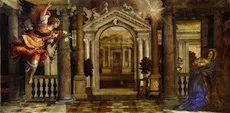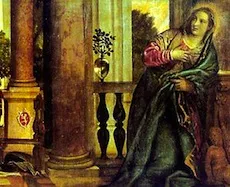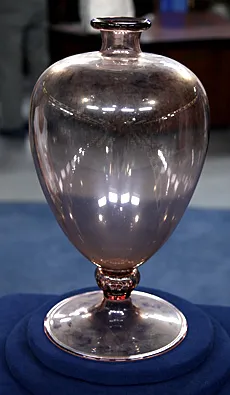Art Inspiring Art: Murano Glass
In Venice, a city known for its robust glassmaking history, the Gallerie dell'Accademia is home to *The Annunciation*, an Italian Renaissance painting by Paolo Veronese (1528-1588) depicting the scene when the Virgin Mary is told that she is carrying the child of God. Rich in color and golden light, the scene primarily depicts icons of the divine. But to the left of Mary's figure, viewers can spot a small translucent vessel — a vase whose delicate and difficult-to-produce form inspired glass designer Vittorio Zecchin in 1921.
Nov 2, 2016
Originally published on: May 27, 2013
The vase was a signature piece designed in 1921 by Vittorio Zecchin, the first director of the firm, and was inspired by Veronese's Annunciation.
In Venice, a city known for its robust glassmaking history, the Gallerie dell'Accademia is home to The Annunciation, an Italian Renaissance painting by Paolo Veronese (1528-1588) depicting the scene when the Virgin Mary is told that she is carrying the child of God. Rich in color and golden light, the scene primarily depicts icons of the divine. But to the left of Mary's figure, viewers can spot a small translucent vessel — a vase whose delicate and difficult-to-produce form inspired glass designer Vittorio Zecchin in 1921.

Veronese's painting, The Annunciation (1578), hangs in the Gallerie dell'Accademia in Venice.
Image of The Annunciation from WikiPaintings.org

The glass vessel featured in The Annunciation inspired glassmaker Vittorio Zecchin to create a vase in its likeness.

The Veronese vase was named after the Italian painter and became a signature piece for the firm Cappelin Venini, based in Murano.
During ANTIQUES ROADSHOW's 2012 visit to Seattle, Washington, a similar vase was presented to glass expert Arlie Sulka. "My father was a security salesman," ROADSHOW guest Susan said, "and occasionally, some of his clients would give him a gift as a thank you for the work he was doing." Her family acquired the delicate aubergine piece in the 1970s, but she had always wondered whether it was true art glass.
As Sulka inspected the piece, it became clear to her that it was, in fact, a true piece of Venini Murano glass. Judging by a two-lined mark on the underside, coupled with the piece's imperfections, larger size, and color, Sulka was able to determine that the glass was made between 1925 and 1935 by a firm called Cappellin Venini in Murano, an island in the Venice Lagoon. It was also called a Veronese vase, after the Italian painter by that name who depicted the inspirational glass in his painting, The Annunciation. Like his contemporaries who painted in Venice, Veronese painted multiple commissioned versions of The Annunciation; however, this particular one depicts the vase on which Zecchin based his 1921 design. The glass was a signature piece by Zecchin, the first director of the firm, and has evolved to different commemorative iterations of the elegant, bulbous form over the years.
Dating back to the 8th century, since well before the Renaissance, Venice has been renowned for its art glass. In 1291, the glassmaking center was moved to Murano. "There are two schools of thought as to why it got moved," Sulka explained. "One was that they were concerned that fire from the furnaces could burn down Venice ... [the other is] that the people in Venice wanted to keep all of the glassmaking localized ... so that they could keep their glassmaking secrets from leaking out."
No matter the reason why the center of Venetian glassmaking moved to Murano, the island became home to the firm of Cappelin Venini. Vittorio Zecchin had been a quite well-known graphic designer, painter, and glass designer. The Veronese vase uncovered in Seattle that he designed became a signature vase for Venini — in fact, the piece was recreated for Venini's 90th anniversary in smaller, more opaline versions.
Despite a few imperfections on the piece, Sulka appraised the Murano vase for a retail value between $3,000 and $4,000.
(Editor's Note: This article was modified on May 28, 2013, to correct an error in which the Renaissance painting *The Annunciation* by Titian was incorrectly cited as the inspiration for this Veronese glass vase. The painting that inspired this glass form was in fact a 1578 painting by Veronese, also titled *The Annunciation*, which hangs in the collection of the Gallerie dell'Accademia in Venice.)


